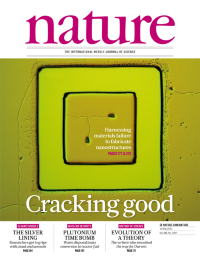Volume 485
-
No. 7400 31 May 2012
The tomato (Solanum lycopersicum) is a major crop plant worldwide and a model organism for the Solanaceae family of flowering plants. It is widely used for the study of fruit biology and disease resistance. A high–quality genome sequence of a domesticated tomato – the Heinz 1706 cultivar – has now been determined, together with a draft sequence for its closest wild relative, the currant tomato Solanum pimpinellifolium. Comparative genomics identifies only 0.6% difference between the two, but a divergence of more than 8% from the potato, Solanum tuberosum, which was sequenced last year. The tomato and S. pimpinellifolium sequences also record the bottlenecks that have narrowed genetic diversity: domestication in the Americas; the export of a few genotypes to Europe in the sixteenth century; and centuries of intensive breeding. Cover: natu/Shutterstock.
Nature Outlook
-
No. 7399 24 May 2012
The rorqual whales include the largest vertebrates known, living or extinct. Their natural history is well known — they have been hunted for centuries — yet many details of their biomechanics and morphology remain obscure. They have evolved 'lunge feeding', a method unique among vertebrates, which involves swimming at speed while gulping large volumes of water laden with fish, krill or other prey. Now, an interdisciplinary team reports the discovery in the jaws of fin, minke and other rorqual whales of a previously unknown sensory organ that has a crucial role in coordinating lunge feeding. The organ is formed from vascular and nervous tissue derived from the ancestral, anterior-most tooth socket and contains mechanoreceptors that record the dramatic changes in jaw position and throat-pouch expansion during a lunge. The cover shows a Bryde's whale (Balaenoptera edeni) feeding on sardines off Baja California, Mexico. (Credit: Doug Perrine/naturepl.com)
-
No. 7398 17 May 2012
Four papers in this issue of Nature present the long-awaited high-resolution crystal structures of the four known opioid receptors in ligand-bound conformations. These G-protein-coupled receptors are the targets of a broad range of drugs, including painkillers, antidepressants, anti-anxiety agents and anti-addiction medications. Brian Kobilkas group reports the crystal structure of the µ-opioid receptor bound to a morphinan antagonist and the &dgr;-opioid receptor bound to naltrindole. Raymond Stevens group reports on the &kgr;-opioid receptor bound to the selective antagonist JDTic, and the nociceptin/orphanin FQ receptor bound to a peptide mimetic. In an associated News and Views, Marta Filizola and Lakshmi Devi discuss the implications of these landmark papers for research on the mechanisms underlying receptor function and drug development. Cover: Universal Images Group/Getty Images.
Nature Outlook
-
No. 7397 10 May 2012
Crack propagation is usually associated with materials failure, and as such is to be avoided. In the right place, however, crack formation can be useful. A team based in South Korea has developed a technique that harnesses crack initiation, propagation and termination to create patterns in a silicon nitride thin film deposited on top of a silicon substrate. Nam et al. introduce into the substrate notches that concentrate stress to initiate cracks spontaneously during deposition; they also define three modes of crack propagation and prepare multistep structures in the silicon substrate to terminate propagation at specific locations. They even bend cracks in a way that resembles the refraction of light. This concept opens up new possibilities for nanofabrication and patterning using fracture mechanics in applications such as nanotechnology and micro-scale fluidic devices. The cover image shows a structure etched into a silicon substrate using the technique.
-
No. 7396 3 May 2012
The story of how humans peopled the planet once seemed so simple. Modern humans, it was thought, left Africa for Asia about 50,000 years ago, reached Europe 10,000 years later and then headed for the Americas. Meanwhile, the Neanderthals and other rivals faded into the background. But we now know that the picture was far more complicated than that. A series of special features in this issue of Nature sets out the latest thinking on where we came from and who we are. Cover by Kyle Bean.





